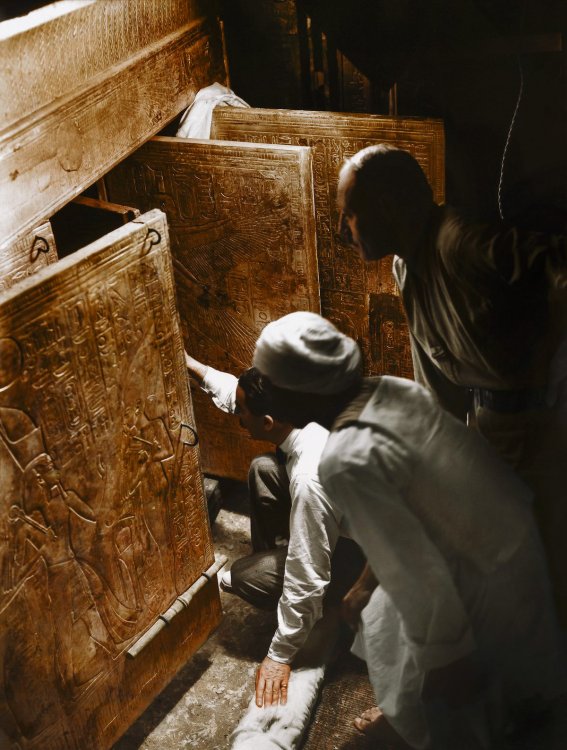There are so countless legends around the tomb of one of the most famous Egyptian kings. For some legends, a scientific explanation has yet to be found, while others are completely absurd. For example, the “curse of the pharaoh” claims that one who enters the tomb will be paid a visit by the angel of death. For a long time, archaeologists who managed to reach the ancient tomb died after some time. In 2002 the legend was dispelled by epidemiologist Mark Nelson, who studied the lives of the first expedition members to find the tomb. As a result, he concluded that only 25 people could have been exposed to the harmful influence of the mummy. Most of the participants lived up to 70 years, and after the opening of the tomb, on average, they lived another 21 years. The archaeologists who were not present at the time of the discovery lived five years longer, but they were younger. Thus, none of the participants suffered sudden death, and the catchy headlines about the legend disappeared from newspapers. The “only” thing that the seekers managed to do was to open the veil of mystery about the Egyptian king to the world, making the main archaeological discovery of the 20th century.
Discovery
Tutankhamun’s tomb was discovered by archaeologist Howard Carter, who dreamed of making a revolutionary discovery – finding an untouched tomb. The scientist found a companion: an amateur archaeologist Lord Carnarvon. Obsessed with a common goal, they began excavations in 1914 and found the tomb of Amenhotep I. But then WWI began, which put a temporary end to the expedition. Carter was unstoppable and after the war, he and the lord returned to the search. For a long time, they searched to no avail, but random objects with the name of Tutankhamun proved the existence of a mysterious figure.
On November 4, 1922, Carter noticed a strange step in the rock. That’s when it all started. The expedition continued with special enthusiasm because the clue was very close.
Soon they found a staircase, and then a door firmly walled up with stones and a double seal. It was an untouched royal seal and the main proof. The telegram Carter sent to his patron reads, “At last have made wonderful discovery in Valley; a magnificent tomb with seals intact; re-covered same for your arrival; congratulations.”
By November 26, 1922, the passage inside was free. Howard Carter described this historical moment in detail, “With trembling hands I made a tiny breach in the upper left-hand corner. Darkness and blank space, as far as an iron testing-rod could reach, showed that whatever lay beyond was empty, and not filled like the passage we had just cleared. Candle tests were applied as a precaution against possible foul gases, and then, widening the hole a little, I inserted the candle and peered in, Lord Carnarvon, Lady Evelyn and Callender [an assistant] standing anxiously beside me to hear the verdict. At first, I could see nothing, the hot air escaping from the chamber causing the candle flame to flicker, but presently, as my eyes grew accustomed to the twinkling light, details of the room within emerged slowly from the mist, strange animals, statues, and gold – everywhere the glint of gold. For the moment – an eternity it must have seemed to the others standing by – I was struck dumb with amazement.”
In the underground hall, there were three large, gilded couches with elongated figures on the sides. Dark full-length sculptures of the pharaoh stood against the walls. They were dressed in aprons and golden sandals, with maces on their heads and staffs in their hands. The statues were “guarding” the camouflaged passage.
In the room, there were also chests with the finest paintings and inlays, alabaster vessels, exquisite chairs, the throne of the king made of real gold, and many other treasures that preceded the entrance to the tomb. In total, more than six hundred items were counted.
The opening of sarcophagi began in the 1920s. In one of them, there was a golden image of the young king. Inside the pharaoh’s sarcophagus, there was a mummy with a death mask made of 11.26 kg of pure gold and gemstones. It is still considered one of the main treasures.
This is how the discovery of the untouched tomb of Tutankhamun inscribed the names of two archaeologists in the history of world science.
Who was he?
For a long time, nothing was known about Tutankhamun. And only in 2007–2009, a team of scientists led by Zahi Hawass conducted a comprehensive study. As a result, it turned out that Tutankhamun did not live very long because of poor health. He had many chronic diseases: cleft hard palate, clubfoot, Köhler disease (deformities and necrosis of tissues caused by a violation of the blood supply to individual bones of the foot). And on the eve of his death, he suffered a hip fracture. During a genetic study, the malaria pathogen was found in the tissues of the pharaoh’s brain, due to which Tutankhamun suffered malarial encephalitis with complications, which became the probable cause of the young king’s death.
Scientists scanned the mummy with a tomograph and concluded that the approximate age of death of Tutankhamun was 19 years. And the elegant images of the ruler were only a tribute to the tradition of depicting kings, emphasizing their divine status.
Photo on the homepage: musthaveforyou.mediasole.ru
Photo on the page: musthaveforyou.mediasole.ru
























